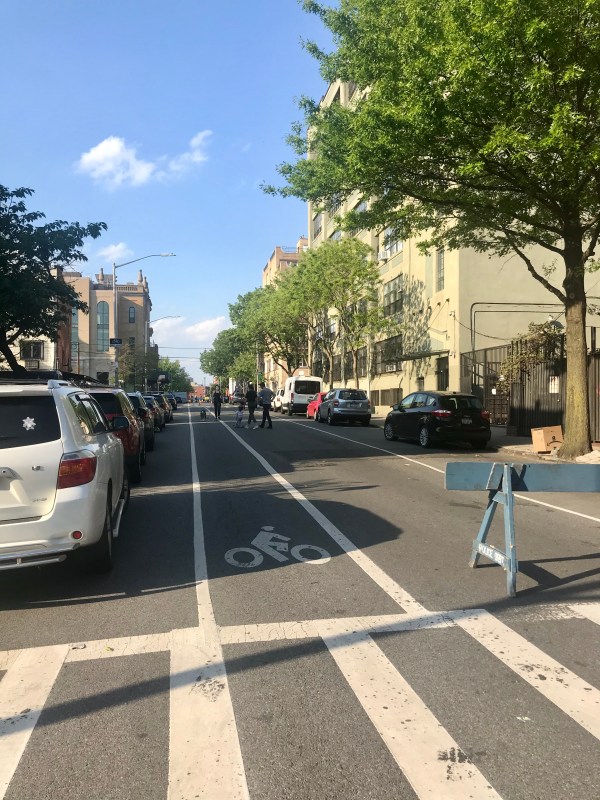Brooklyn Pol Proposes Another Car-Free Busway
Berry Street, an open-street success story in Williamsburg, could replace the stalled BQX connector, a Council member says.

One of the city’s most successful open streets should be turned into a car-free busway, according to a local elected official.
Council Member Antonio Reynoso said that Mayor de Blasio and the Department of Transportation should learn their lesson from the radical transformation of Berry Street in Williamsburg and restrict traffic permanently to buses, bikes, and pedestrians — with no private cars.
A car-free busway on Berry Street between Broadway and North 12th Street could take the place of the now indefinitely stalled Brooklyn Queens Connector, or BQX — a light-rail project that was supposed to run along the same street near the Brooklyn waterfront.
“Berry should be a busway both ways, no cars, just buses, express buses — whatever the BQX wanted to do in bus format,” said Reynoso, who represents Williamsburg, said during a virtual Council oversight hearing on the DOT’s response to COVID-19.
The mile-long stretch is a mostly residential street with one lane of traffic, a painted bike lane, and parking lanes on each side. No buses stop on the street, but several routes traverse adjacent streets, including Wythe, Kent, and Bedford avenues, and Franklin Street.
If Berry Street becomes a two-way busway, the B32 and B62 could be consolidated on it. pic.twitter.com/xfP2BGbZfW
— Union Tpke (@Union_Tpke) September 9, 2020
The proposal seeks to capitalize on the success of the city’s open streets program, which now covers 75 miles, according to the DOT. In April the city announced that it would open 100 miles of streets in order to enable New Yorkers to enjoy socially distanced recreation during the coronavirus pandemic.
Many streets in the city’s Open Streets program initially failed. In some cases, the barricades sealing the streets from through traffic were missing or broken; in others, no one showed up to put the barricades in place. Some local politicians criticized the program for excluding areas that were hard hit by the deadly virus, saying that it catered to wealthy neighborhoods that already were rich in resources and green space.
But the program has proved its worth and grown. And Berry Street, which the city has opened each day from 8 a.m. to 8 p.m., counts as a major success, said DOT Commissioner Polly Trottenberg.
“It has been on our of our most successful open streets. I’ve been out there; it’s terrific,” Trottenberg said during the virtual hearing. “You raise the question that we’ve grappled with this summer, which is the sustainability of maintenance and that is a real challenge.” Trottenberg did not address Reynoso’s request to turn the street into a permanent, car-free busway.
Commissioner Trottenberg called Berry Street one of the most successful open streets so far! This is really a testament to @NBk_OSCC’s many volunteers & organizations & businesses that have been supporting this initiative
— Elana Ehrenberg (@elanaehrenberg) September 9, 2020
The opening of the street to pedestrians and cyclists, and the restriction of car traffic, has not only allowed the community to reap the benefits of more open space. It also has made the street safer. From May through August on the one-mile, open stretch of Berry Street, there were just five crashes, causing two injuries, including one cyclist and two motorists. No pedestrians were hurt. During the same three months in 2019, when the street was open to through traffic, there were nine crashes, causing eight injuries, including to two cyclists, four pedestrians, and two motorists, according to Crash Mapper.
Busways also increase safety. Since 14th Street in Manhattan turned into a busway last October, crashes through January dropped by 53 percent and injuries by 63 percent, compared to the same time period in the year earlier before it launched, Streetsblog reported.
The need for car-free streets has mounted because of the city’s pandemic-induced bike boom — cycling is up a whopping 57 percent on weekends and 26 percent on protected bike lanes and bridges, compared to the same time period last year, Trottenberg said during the hearing.
The city’s record of establishing busways has been mixed. Back in June, de Blasio announced that the city would urgently install five busways in order to make straphangers’ commutes faster and more reliable, especially because so many bus riders are essential workers whose labor has kept the city afloat during the pandemic. But of the five promised busways, only the one on Jay Street in Downtown Brooklyn has debuted. Still, the city is plowing ahead: Another busway is set to start on 181st Street in Washington Heights this November.
Transportation Commissioner discusses cycling boom
26% more cyclists on protected lanes/bridges, compared to last year
Weekend cycling up 57%
9 miles of permanent/protected bike lanes installed during pandemic
7 more on the way
— Dan Rivoli (@danrivoli) September 9, 2020
Love this! @ReynosoBrooklyn wants to make Berry Street a busway, "whatever the #BQX wanted to do." No cars. Bikes and buses only!
The Berry Street Open Street corridor has been one of my favorite routes to/from the WillyB this year!
— Laura Shepard (@LAShepard221) September 9, 2020





